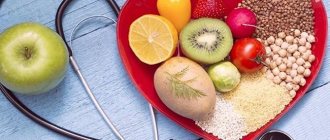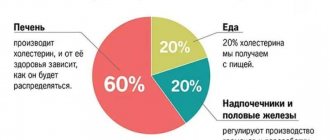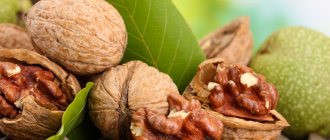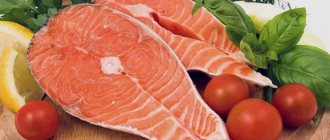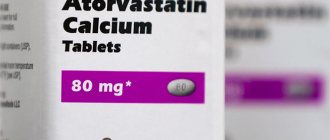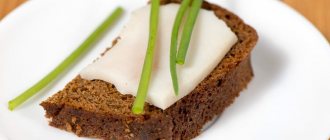Nutrition for a hypocholesterol diet
Most of the cholesterol is produced by the body itself for the functioning of vital processes. Sometimes its laboratory value increases significantly. This leads to deterioration of the blood vessels and excess weight gain. In this case, you should carefully monitor your diet, observing “table No. 10”. This is a low-carbohydrate diet aimed at providing the body with all the necessary vitamins and microelements.
Table No. 10 includes products of plant and animal origin:
- Lean meats provide the body with protein and proper carbohydrates. Fats in small quantities are necessary to maintain human life.
- Vegetables are rich in vitamins and nutrients. With their help, metabolism is accelerated and metabolism is improved.
- Fruits contain acids necessary for the absorption of vitamins.
- Fermented milk products provide the body with calcium.
- Vitamin drinks (for example, rosehip decoction) serve as a source of vitamins and increase the body's immune defense.
- Vegetable oils are a source of fats that do not affect the condition of the heart and blood vessels.
All dishes are prepared by boiling, steaming or stewing. The diet includes a high content of vitamins B and C, microelements (calcium, potassium, magnesium). When serving, the temperature of the dish can be any. This indicator has nothing to do with the formation of cholesterol.
Pain in the heart area makes almost every person worry, because the first thing that comes to mind is serious life-threatening pathologies. However, among the causes of chest pain when inhaling, other diseases are also distinguished. Read more in the article: “colitis in the heart area when inhaling.”
Individual differences
In order for the diet to bring positive results from its use, you need to listen to the advice of nutritionists:
- Bread and products made from premium wheat flour contain calories that are stored in fat;
- Eating whole grain bread, or rye bread, is beneficial for the body;
- Eat vegetable soups for lunch - okroshka, cold or hot beetroot soup;
- White meat must be boiled or baked in foil in the oven;
- Consume low-fat fermented milk products daily;
- With a hypocholesterolemic diet, steam omelettes must be prepared 2 times a week from one egg. Egg white omelette can be eaten daily;
- Cereal-based porridges should be cooked in water and do not add salt during cooking;
- The maximum amount of vegetables daily is up to five types of vegetables, as well as fruits and berries;
- In addition to purified water, you need to drink weak tea or coffee, as well as vegetable and fruit juices and fruit drinks.
With a standard hypocholesterolemic diet, you can reduce the number of snacks throughout the day, or you can eat larger amounts of cholesterol-free foods for breakfast and lunch.
Diet "table No. 10"
Table No. 10 is prescribed for patients with hypertension and other cardiovascular diseases. It is also followed by people at risk (hereditary predisposition). The diet builds proper metabolism. Its principle is based on protecting the body from the accumulation of excess cholesterol and saturating it with all useful elements. The salt content in the menu is kept to a minimum. Sugar is used in limited quantities.
The coefficient used (proteins/fats/carbohydrates) is calculated depending on the patient’s weight. When compiling a menu, its individual characteristics and reactions to all components of the diet are taken into account. The diet resembles a children's menu. It completely excludes spicy, smoked, fried, salty dishes. The main emphasis is on high protein content. Their function in the body is construction. With the help of the synthesis of these elements, vital processes are carried out in all organs.
Advertising:
Depending on a person’s weight, the following daily norms are prescribed:
- For a patient with normal height-to-weight ratio:
- easily digestible carbohydrates - 400 g;
- vegetable and animal proteins - 100 g (50/50);
- fats - 80 g.
The calorie content of this diet is 2650 kcal.
It is difficult to meet a representative of the fair sex who is not familiar with the phrase “they often drag their feet.” Women's legs really require special attention, and caring for them begins with identifying the causes of discomfort and competent medical diagnosis. Read more in the article: “women’s legs are pulled.”
For an obese person:
- carbohydrates - 300 g;
- proteins - 80 g;
- fats - 70 g.
The calorie content of the daily menu is 2200 kcal. In both cases, meals are provided in fractions - in 4-5 meals (small portions).
What is it used for?
Cholesterol in the human body is a very important building element for all cell membranes.
If fat-containing alcohol does not exceed standard values, then the lipid process in the body occurs normally, and a person should not go on a cholesterol-lowering diet.
You just need to adhere to the basic rules of a healthy diet and eat less foods containing natural animal fat.
If the total cholesterol level is higher than the standard level of 5.5 mmol per liter of blood, then you should think about it, because there is an excess of lipoprotein molecules in the blood. This excess cholesterol affects the heart organ as well as the blood flow system of the human body.
If you do not use a hypocholesterolemic diet in the fight against a high cholesterol index in the blood, then this is fraught with the development of such pathologies in the body that are dangerous due to their complications and consequences:
- Atherosclerosis;
- Phlebeurysm;
- Thrombosis of large diameter arteries;
- Trophic ulcer;
- Stagnation of blood in the pulmonary artery and organs;
- Failure of the heart organ;
- Improper functioning of the heart valve apparatus;
- Cardiac arrhythmia;
- Arterial aneurysm.
To avoid the development of these pathologies and their transition to a complicated form of heart attacks or strokes, a hypocholesterolemic diet has been developed.
Sample menu for the week
The cholesterol-lowering diet aims to reduce cholesterol through a balanced diet. It is intended for home use. There are a large number of recipes that will make it healthy and varied. Sample menu for the week:
| Mon | W | Wed | Thu | Fri | Sat | Sun | |
| Breakfast | oatmeal - 100g; sandwich with cheese or a thin layer of butter; tea without sugar. | pearl barley porridge with milk; cottage cheese (mild sweetness); black tea with lemon. | steam omelette; chicory or black tea with lemon. | wheat porridge with milk (low-fat); juice diluted with water. | millet porridge; tea. | oatmeal on water; juice. | cottage cheese and berry casserole; chicory. |
| Snack | Fresh fruit (apple/pear/orange) | Berries (50-100 g) | Apple and pear puree | Orange | Apple | Cottage cheese with berries | Carrot pudding |
| Dinner | noodle soup with secondary broth; fish cutlet (low-fat) - 100 g; dried bread, compote. | beef broth soup; stewed cabbage; steam cutlet; apple compote. | peasant soup with recycled broth; pearl barley with beef goulash. fruit drink | stewed vegetables; bread; chicken fillet cutlet; compote. | borsch; boiled fish; compote. | cabbage soup; stewed vegetables; boiled chicken; compote. | vegetable soup; boiled poultry meat; stew; fruit drink |
| Afternoon snack | Milk soup with cereals (no sugar) | 2 oatmeal cookies (homemade); compote or juice diluted with water. | Baked apple with curd filling | rosehip decoction; 2 Croquette cookies | Morse | oat cookies; rosehip decoction. | Compote |
| Dinner | Vegetable salad (vinaigrette), tea (green) | boiled chicken meat (from the breast); raw vegetable salad, tea. | boiled beef; vitamin salad from cabbage and carrots; juice diluted with water. | pearl barley porridge; kefir (low fat). | risotto; tea. | steamed beef cutlet; salad; tea. | meat soufflé; juice. |
It is necessary to include seafood, fish and nuts in your diet (up to 30 g per day). The menu should change every week. You can add additional ingredients to dishes, make baked goods from oatmeal, coconut, or rice flour.
The last meal is taken no later than 2 hours before bedtime.
In the first half of the day, the calorie intake is much higher than in the second. Dinner consists of light foods.
Advertising:
Interesting recipes for healthy dishes
Even if the menu described above seemed rather boring, you can diversify it by using different options for vegetables, fruits and cereals, of which there are a huge variety. You've probably noticed that almost every day you have to deal with preparing vegetable salads.
To enhance your culinary skills and diversify your diet, we have prepared some interesting and quick-to-prepare vegetable salads.
Vegetable salad based on mushrooms
To prepare it you will need:
- 30 g lettuce leaves;
- 400 g mushrooms;
- 100 ml vegetable broth;
- 2 tbsp. vinegar;
- 1 tsp olive oil;
- 1 bunch of spinach.
The first step is to peel and chop the spinach leaves, as well as the mushrooms themselves. Next, put the mushrooms in a frying pan and pour in vegetable broth. Cover with a lid and cook for about 2 minutes until the broth is absorbed into the mushrooms. Mix mushrooms with lettuce and spinach, season with vinegar, olive oil, and you can add ground black pepper to taste.
Quick salad with salmon
To prepare the dish you will need:
- 250 g white cabbage;
- 250 g red cabbage;
- 150 g cold smoked salmon;
- 100 g apples;
- 100 ml yogurt;
- 1 tsp vinegar;
- 2 tbsp. lemon juice.
First, chop the white and red cabbage. Then cut the apples, remove the core, chop them into small strips and pour 1 tbsp. lemon juice. Cut the salmon into thin strips. The dressing sauce is prepared by mixing yogurt, vinegar and the remaining lemon juice. All that remains is to mix the ingredients and season with sauce.
Advice for women and men
The bodies of men and women have different standards for the consumption of nutrients. This is due to different hormonal status, weight and height ratio. Tips for men:
- Hypertensive men need a lot of protein. Their diet is dominated by meat and dairy products. The most protein compounds are found in poultry, beef, nuts, and cottage cheese.
- Men are more likely than women to suffer from cardiovascular diseases. After 40 years, you should regularly monitor your blood cholesterol levels in order to pay attention to your diet in time.
- B vitamins must be present in the foods consumed. They improve blood composition and have a beneficial effect on blood circulation in general.
- Vitamin C strengthens blood vessels and makes them elastic. Vitamin therapy is included in preventive measures for a hypocholesterol diet.
Advice for women:
- When drawing up a weekly diet, it is important to pay attention to the protein/fat/carbohydrate ratio.
- Recipes should be varied, which minimizes the possibility of failure.
- Women's menus should be enriched with fruit acids, focusing on the consumption of fresh fruits.
In both cases, you need to drink a glass of purified water before eating. This promotes proper digestion. You should avoid sweet pastries, cocoa, and coffee.
Advertising:
Contraindications
Since the diet involves a significant restriction of sodium intake, as well as an increase in potassium and magnesium intake, it has a number of contraindications. Doctors do not recommend following diet No. 10 for pregnant women, lactating mothers and young children.
Also, this diet plan is not suitable for people who have serious kidney problems or suffer from cancer.
Recommended and prohibited products
When selecting recipes, you need to take into account their composition. Some foods are strictly prohibited for people with high cholesterol. These include spicy, salty, fried foods, and smoked foods. List of permitted and prohibited products:
| Can | It is forbidden | |
| Meat | lean poultry meat (chicken, quail); veal, beef, rabbit, horse meat. | fatty poultry meat: duck, goose, turkey; pork, lamb, lard. |
| Animal by-products | Liver, kidneys, tongue (beef) | Heart, brains, smoked meats from any offal |
| Poultry by-products | Heart, liver, stomach | Salted and smoked products |
| Sausages | Low-fat sausages, chicken ham | Pate, fatty sausages, salami, sausages |
| Fish | Trout, pike, tuna, cod | Carp, herring, salmon |
When preparing meals, only recommended products should be used. Otherwise, the amount of cholesterol may increase, continuing to clog blood vessels.
Who else needs to adhere to the “Table No. 10” regime?
Advertising:
A balanced diet should be maintained on an ongoing basis. Some categories of people especially need a therapeutic diet:
- Hypertensive patients
. People suffering from high blood pressure are susceptible to vasoconstriction. A high cholesterol level can cause their obstruction, settling on the vascular walls in the form of plaques. This category of patients needs to carefully monitor their diet, avoiding prohibited foods. - Diabetics
. If the patient is at risk for diabetes, then his diet consists of constantly calculating the glycemic index of foods. Table No. 10 includes low GI ingredients.
The normal level of total cholesterol changes with age. If in children and young people it varies from 3.1 to 5 mmol/l, then in a person over 50 years old, 6 mmol/l is considered normal. Elderly people with borderline indicators should monitor their diet when switching to a therapeutic diet.
The essence
Brief description of the diet. Type: therapeutic, hypolipidemic. Duration: until cholesterol levels normalize or for life if hypercholesterolemia is chronic or there is a predisposition to it. Results: keeping LDL concentration in the blood within normal limits, minimizing complications. Difficulty: medium.
For high cholesterol, a diet is prescribed, which is characterized by the following features:
- constant monitoring of daily caloric intake;
- compliance with the principles of proper nutrition;
- optimal balance of all nutrients necessary for the body (BJU);
- using the characteristics of a balanced diet: taking into account climate, concomitant diseases (hypertension, Gilbert's syndrome, obesity, diabetes), age, cholesterol level, gender differences, degree of complications.
The main feature of the diet is its therapeutic effect. It is intended primarily to normalize well-being and reduce the risk of complications. Therefore, first you need to consult with a specialist (therapist, cardiologist, phlebologist) to clarify the diagnosis, and then, with the test results and doctors’ conclusions, contact a nutritionist who will help you create the right menu. Subsequently, based on it, you can develop your own version of the diet.
